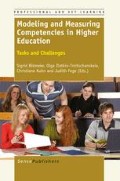Abstract
The Berkeley Evaluation and Assessment Research (BEAR) Center has developed an assessment system called the BEAR Assessment System (BAS), which is based on four principles of sound assessment (Wilson, 2005). In turn, each principle is associated with a practical “building block” that embodies the way in which the principle is used in an assessment context, and the whole system is brought together by an integrative activity that can take on different aspects under different circumstances (e.g., assessment moderation, cut score setting, etc.).
Access this chapter
Tax calculation will be finalised at checkout
Purchases are for personal use only
Preview
Unable to display preview. Download preview PDF.
References
Adams, R. J., Wilson, M., & Wang, W.-C. (1997). The multidimensional random coefficients multinomial logit model. Applied Psychological Measurement, 21, 1–23.
Biggs, J., & Collis, K. (1982). Evaluating the quality of learning: The SOLO taxonomy. New York: Academic Press.
Black, P., Harrison, C., Lee, C., Marshall, B., & Wiliam, D. (2003). Assessment for learning. London: Open University Press.
Black, P., & Wilson, M. (2009). Learning progressions to guide systems of formative and summative assessment. Paper presented at the Annual Meeting of the American Educational Research Association, San Diego, April.
Briggs, D., Alonzo, A., Schwab, C., & Wilson, M. (2006). Diagnostic assessment with ordered multiple-choice items. Educational Assessment, 11(1), 33–63.
Claesgens, J., Scalise, K., Wilson, M., & Stacy, A. (2009). Mapping student understanding in chemistry: The perspectives of chemists. Science Education, 93(1), 56–85.
Draney, K., & Kennedy, C. (2010). The standard-setting criterion mapping method. In C. Harsch, H. A. Pant & O. Koller (Eds.), Calibrating standards-based assessment tasks for English as a first foreign language. Standard-setting procedures in Germany (Vol. II) pp. 75–88. Munster: Waxmann.
Draney, K., Kennedy, C., Moore, S., & Morrell, L. (2010). Procedural standard-setting issues. In C. Harsch, H. A. Pant & O. Koller (Eds.), Calibrating standards-based assessment tasks for English as a first foreign language. Standard-setting procedures in Germany (Vol. II) pp. 89–121. Munster: Waxman.
Frechtling, J. (1997). Best practice in action: Final report of the multi-agency study of teacher enhancement programs. Washington, DC: National Science Foundation.
Glaser, R. (1990). Testing and assessment: O tempora! O mores! Pittsburgh: LRDC, University of Pittsburgh.
Kennedy, C. A., Wilson, M., Draney, K., Tutunciyan, S., & Vorp, R. (2008). ConstructMap Version 4 (computer program). University of, Berkeley, CA: BEAR Center.
Land, R. (1997). Moving up to complex assessment systems. Evaluation Comment, 7(1), 1–21.
Linn, R., & Baker, E. (1996). Can performance-based student assessments be psychometrically sound? In J. B. Baron & D. P. Wolf (Eds.), Performance-based student assessment: Challenges and possibilities. Ninety-fifth yearbook of the National Society for the Study of Education. Chicago: University of Chicago Press.
Masters, G., & Forster, M. (1997). Mapping literacy achievement: Results of the 1996 National School English Literacy Survey. Hawthorn, Australia: ACER Press.
Mohan, L., Chen, J., & Anderson, C. W. (2009). Developing a multi-year learning progression for carbon cycling in socio-ecological systems. Journal of Research in Science Teaching, 46(6), 675–698.
Resnick, L. B., & Resnick, D. P. (1992). Assessing the thinking curriculum: New tools for educational reform. In B. R. Gifford & M. C. O’Connor (Eds.), Changing assessments (pp. 37–76). Boston: Kluwer Academic Publishers.
Roberts, L., & Sipusic, M. (1999). Moderation in all things: A class act [Film]. (Available from the Berkeley Evaluation and Assessment Center, Graduate School of Education, University of California, Berkeley, Berkeley, CA 94720-1670).
Ruskus, J., & Luczak, J. (1995). Best practice in action: A descriptive analysis of exemplary teacher enhancement institutes in science and technology. Washington, DC: National Science Foundation (Prepared under contract #SED 9255370).
Wilson, M. (2005). Constructing measures: An item response modeling approach. Mahwah, NJ: Erlbaum.
Wilson, M., & Adams, R. J. (1996). Evaluating progress with alternative assessments: A model for Chapter 1. In M. B. Kane (Ed.), Implementing performance assessment: Promises, problems and challenges. pp. 39–60.. Hillsdale, NJ: Erlbaum.
Wilson, M., & Carstensen, C. (2007). Assessment to improve learning in mathematics: The BEAR Assessment System. In A. Schoenfeld (Ed.), Assessing mathematical proficiency (pp. 311–332). London: Cambridge University Press.
Wilson, M., & Draney, K. (2000). Developmental assessment strategies in a statewide testing program: Scale interpretation, standard setting, and task-scoring for the Golden State Examinations. Council of Chief State School Officers National Conference on Large Scale Assessment, Snowbird, UT, June.
Wilson, M., & Draney, K. (2002). A technique for setting standards and maintaining them over time. In S. Nishisato, Y. Baba, H. Bozdogan & K. Kanefugi (Eds.), Measurement and multivariate analysis (Proceedings of the International Conference on Measurement and Multivariate Analysis, Banff, Canada, May 12–14, 2000, pp 325–332). Tokyo: Springer-Verlag.
Wilson, M., & Scalise, K. (2006). Assessment to improve learning in higher education: The BEAR Assessment System. Higher Education, 52, 635–663.
Wilson, M., Scalise, K., Gochyyev, P., Lin, Y.-H., & Torres Irribarra, D. (2010). Progress monitoring for real classroom contexts: The formative assessment delivery system. Paper presented at the Annual Meeting of the American Educational Research Association, Denver, CO, May.
Wilson, M., & Sloane, K. (2000). From principles to practice: An embedded assessment system. Applied Measurement in Education, 13, 181–208.
Wolf, D., & Reardon, S. (1996). Access to excellence through new forms of student assessment. In J. B. Baron & D. P. Wolf (Eds.), Performance-based student assessment: Challenges and possibilities. Ninety-fifth yearbook of the National Society for the Study of Education (Part I, pp. 52–83). Chicago: University of Chicago Press.
Author information
Authors and Affiliations
Editor information
Editors and Affiliations
Rights and permissions
Copyright information
© 2013 Sense Publishers
About this chapter
Cite this chapter
Wilson, M., Draney, K. (2013). A Strategy for the Assessment of Competencies in Higher Education. In: Blömeke, S., Zlatkin-Troitschanskaia, O., Kuhn, C., Fege, J. (eds) Modeling and Measuring Competencies in Higher Education. Professional and Vet Learning, vol 1. SensePublishers, Rotterdam. https://doi.org/10.1007/978-94-6091-867-4_5
Download citation
DOI: https://doi.org/10.1007/978-94-6091-867-4_5
Publisher Name: SensePublishers, Rotterdam
Online ISBN: 978-94-6091-867-4
eBook Packages: Humanities, Social Sciences and LawEducation (R0)


